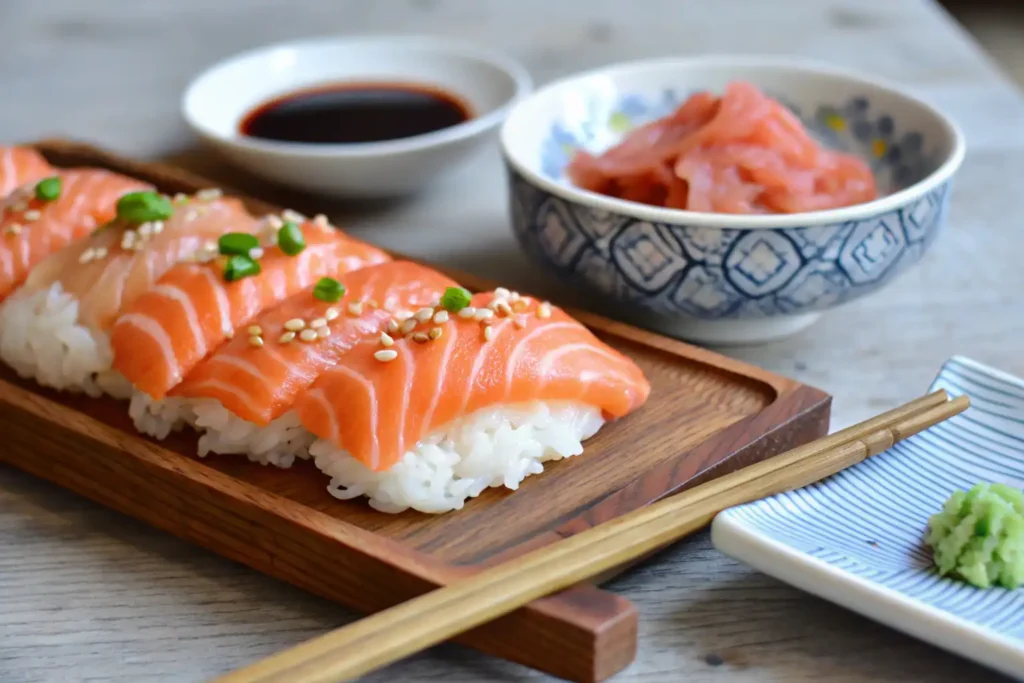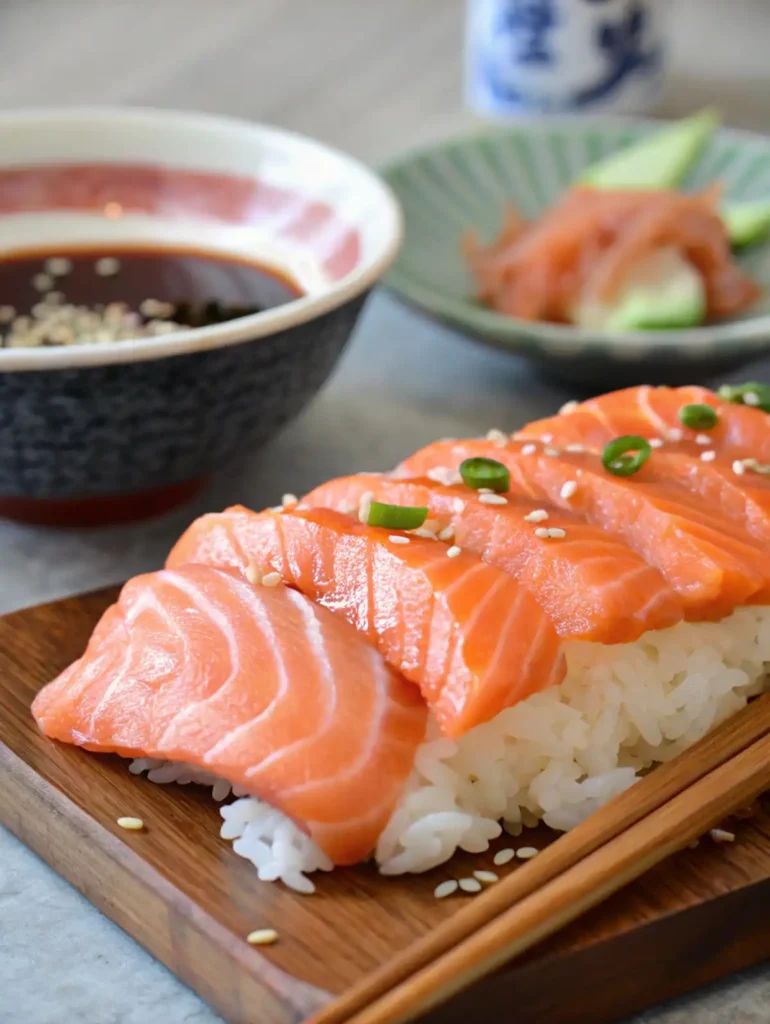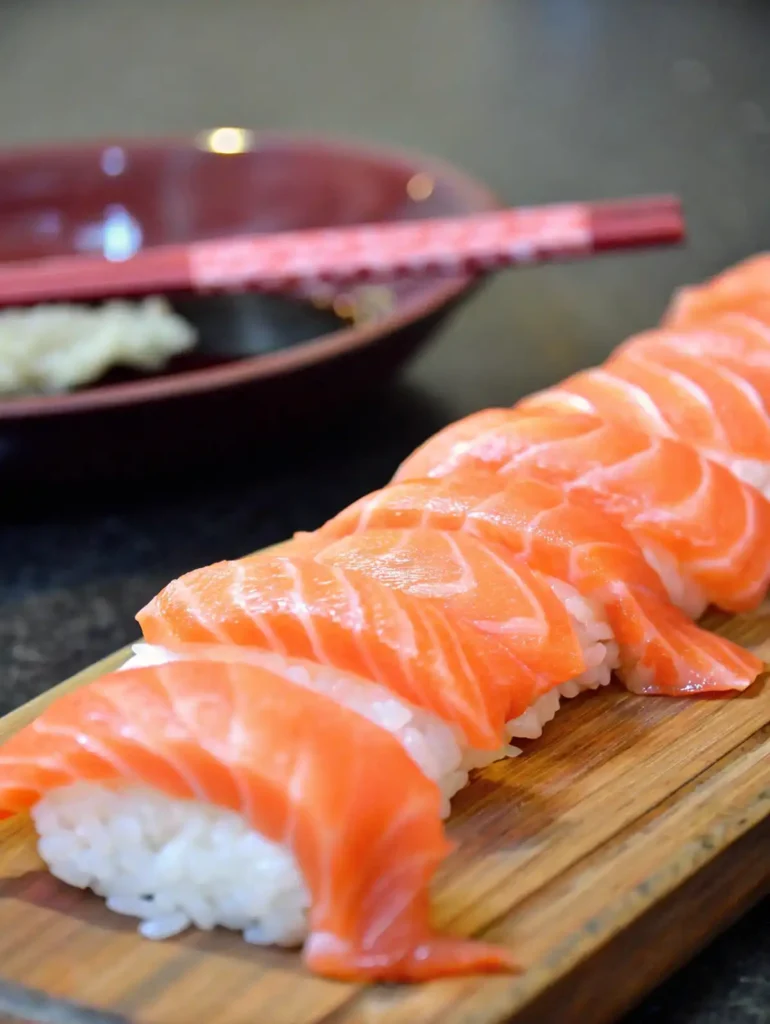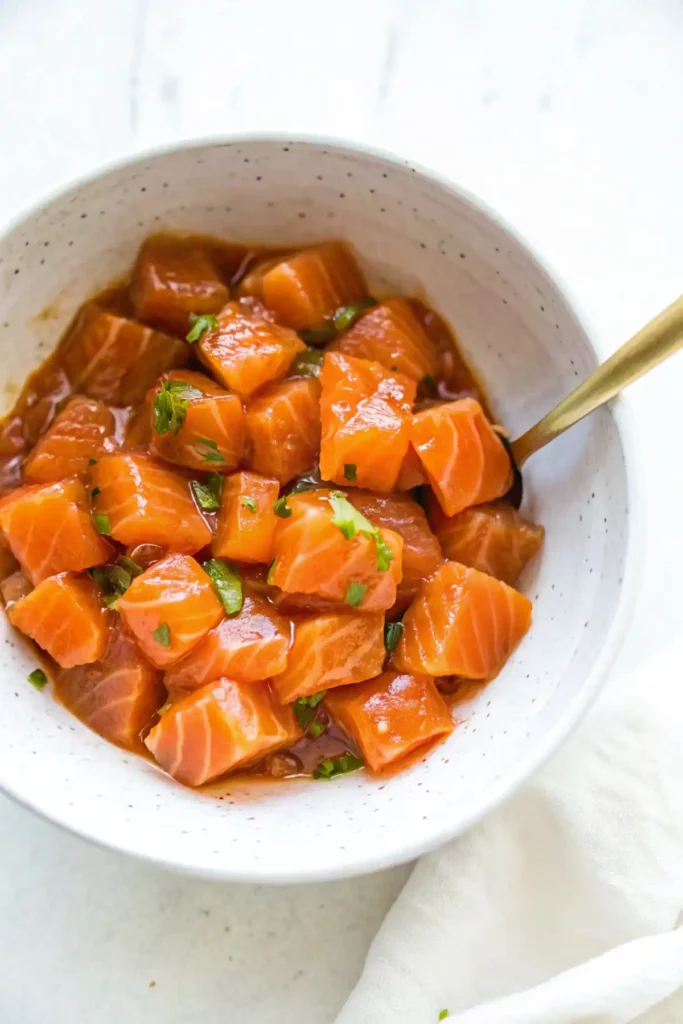If you’ve ever dreamed of making sushi at home, you’ve probably asked yourself: Can I use regular salmon, or does it have to be sushi-grade? It’s a great question, and honestly, the answer is a bit more complicated than you might think. Sushi-grade fish isn’t just about freshness—it’s about safety, preparation, and some pretty strict freezing guidelines.

In this post, we’re diving into everything you need to know about salmon, sushi-grade fish, and whether you can take a regular piece of salmon and make it safe for sushi at home. So grab a cup of tea, and let’s roll (pun intended).
What Does “Sushi-Grade” Actually Mean?
Here’s the thing about the term “sushi-grade”—it’s not regulated by the FDA. Crazy, right? Instead, it’s a marketing term used by fishmongers and stores to indicate that the fish is safe to eat raw. But the lack of regulation doesn’t mean it’s meaningless. In most cases, the store freezes sushi-grade fish in a very specific way to kill parasites and handles it with care to minimize bacteria.
People most commonly associate the term with fish like tuna, salmon, and yellowtail—the types of fish you see in your favorite sushi rolls. For salmon specifically, the risk isn’t just about bacteria; it’s about parasites. These little guys can live in the flesh of the fish and are invisible to the naked eye. That’s why freezing is so important—it kills them off before the fish lands on your plate.
Why Regular Salmon Isn’t Automatically Sushi-Grade

Let’s talk about the salmon you see in your local grocery store. Whether it’s labeled as farmed or wild, fresh or frozen, it’s not guaranteed to be safe for sushi. Here’s why:
- Parasites
Salmon is a high-risk fish when it comes to parasites. Wild salmon, in particular, is more likely to carry parasites because of its diet and natural environment. Farmed salmon has a slightly lower risk, but it’s not zero. - Handling and Processing
Sushi-grade fish is typically handled under stricter guidelines. It’s processed quickly after being caught to minimize the growth of harmful bacteria. Regular salmon may not go through this same careful handling, which increases the risk of contamination. - Freezing Requirements
The FDA has specific guidelines for fish that’s meant to be eaten raw. It must be frozen to a temperature of -4°F (-20°C) for at least seven days or to -31°F (-35°C) for 15 hours. This deep freeze kills parasites, but most home freezers can’t reach these temperatures.
In short, regular salmon isn’t sushi-grade because it hasn’t gone through the necessary steps to ensure safety.
How to Make Regular Salmon Safer for Sushi

If you’re determined to make sushi at home and can’t find sushi-grade salmon, there are steps you can take to reduce the risks. It’s not foolproof, but it’s better than just slicing up a raw filet from your local supermarket. Here’s what you can do:
1. Start with the Freshest Salmon Possible
Freshness is key. Look for salmon that:
- Has bright, vibrant flesh (a deep orange or pink color).
- Smells clean, like the ocean—not fishy.
- Feels firm to the touch.
If you can, ask your fishmonger when the salmon was caught and whether it’s been frozen before. Some stores label their fish as “previously frozen,” which means it might have gone through a freezing process that killed parasites. This isn’t always the same as sushi-grade, but it’s a step in the right direction.
2. Freeze It Properly
This is the most important step if you want to make your salmon safer for sushi. As we mentioned earlier, the FDA recommends freezing fish to specific temperatures to kill parasites. Since most home freezers only go down to about 0°F (-18°C), you might need to get creative.
- Deep Freezer Option
If you have access to a deep freezer that can reach -31°F (-35°C), you can freeze the salmon for at least 15 hours to meet FDA standards. - Regular Freezer Option
If you’re using a standard freezer, you’ll need to freeze the fish at 0°F (-18°C) for at least 7 days. Wrap the salmon tightly in plastic wrap and place it in an airtight container to prevent freezer burn.
3. Handle It with Care
Once your salmon is frozen and thawed, treat it like royalty. Raw fish is more delicate than cooked, so make sure your hands, knives, and cutting boards are squeaky clean. A little cross-contamination can ruin your sushi experience faster than you can say “wasabi.”
Is Homemade Sushi Really Worth the Risk?
Okay, let’s get real for a second. Even if you follow all the steps above, there’s still a small risk when eating raw fish at home. Sushi-grade salmon from a reputable supplier is always the safer bet because it’s been handled and frozen in a way that meets strict safety standards. If you’re new to making sushi, you might want to start with cooked or smoked fish instead. Think California rolls, shrimp tempura rolls, or smoked salmon rolls—they’re delicious and way less stressful to make.
Tips for a Successful Sushi Night at Home
If you’re ready to dive into the world of homemade sushi, here are some tips to make the process smoother (and more fun):
1. Invest in the Right Tools
- A sharp knife is your best friend for clean, even slices of fish.
- A bamboo rolling mat makes it easy to shape your rolls.
- Don’t forget the rice paddle—it helps spread the rice without sticking to everything.
2. Master the Rice
Sushi rice is the heart of any good roll. Use short-grain rice, season it with rice vinegar, sugar, and salt, and let it cool before assembling your rolls. And don’t skimp on the rinsing—nobody wants gummy rice.
3. Get Creative with Fillings
Not ready to go raw? Try cooked shrimp, crab, or even crispy veggies like tempura asparagus. Sushi is all about balance, so mix textures and flavors for a winning combo.
4. Serve It Right
A sushi night isn’t complete without soy sauce, pickled ginger, and a little wasabi. Pro tip: mix a dab of wasabi into your soy sauce for a spicy kick.
Why Buying Sushi-Grade Salmon Is Your Best Bet
At the end of the day, the easiest and safest way to enjoy raw salmon is to buy sushi-grade fish from a trusted supplier. It might cost a little more, but you’re paying for peace of mind. Many specialty seafood markets and online stores sell sushi-grade salmon that the store has frozen to FDA standards. Some even deliver straight to your door—how cool is that?
Why Texture Matters in Sushi-Grade Salmon
When you think about sushi, one of the first things that comes to mind is that buttery, melt-in-your-mouth texture. Achieving this with regular salmon isn’t just about freshness; it’s also about how the store stored and handled the fish. Sushi-grade salmon is typically processed to preserve its firm yet tender texture, which makes it ideal for slicing thin. Regular salmon that hasn’t been frozen properly may lose some of this delicate quality, which could affect your sushi-making experience. Freezing not only ensures safety but can also lock in the right texture for sushi.
Alternatives to Sushi-Grade Salmon

If turning regular salmon into sushi-grade feels too daunting, there are some tasty alternatives. Smoked salmon, for example, is a ready-to-eat option that delivers rich flavor and pairs perfectly with sushi rice and fresh veggies. You can also flake cooked salmon, either grilled or broiled, into rolls or nigiri for a unique twist. These options allow you to enjoy the salmon sushi experience without worrying about the safety of eating it raw.
Storing Leftovers the Right Way
If you’ve frozen and prepared salmon for sushi at home, you might wonder what to do with leftovers. Consume raw salmon immediately for the best experience. If you must store it, place it in an airtight container in the fridge for no more than 24 hours. Any longer, and you risk bacterial growth. For cooked salmon, leftovers can last 2–3 days if stored properly. Incorporating these leftovers into cooked dishes like rice bowls or salads can ensure nothing goes to waste.
FAQs
Can I use salmon from the grocery store to make sushi?
You can use salmon from the grocery store for sushi if the label says ‘sushi-grade’ or ‘safe to eat raw.’ Regular salmon isn’t automatically safe for raw consumption because it may not have undergone freezing to kill parasites. Always ask the store or fishmonger how they handled the salmon.
Can I use normal salmon for sushi?
Normal salmon, like what you’d find in most stores, isn’t safe for sushi unless the store has frozen it to FDA-recommended temperatures to kill parasites. Without proper freezing and handling, it’s better to cook the salmon to avoid any health risks.
How do I make sure salmon is safe for sushi?
To make salmon safe for sushi, freeze it to at least -4°F (-20°C) for seven days or -31°F (-35°C) for 15 hours. This kills parasites that may be present. Alternatively, buy sushi-grade salmon from a trusted source to ensure safety without the need for additional preparation.
Can I use salmon from Whole Foods for sushi?
Yes, Whole Foods often sells sushi-grade salmon that is safe for raw consumption. Check the label or ask the seafood department to confirm that the store has frozen the salmon to FDA standards for sushi preparation.
Wrapping It Up
Turning regular salmon into sushi-grade isn’t impossible, but it’s not something to take lightly. The freezing process is key to killing parasites, and the handling of the fish plays a huge role in its safety. If you’re up for the challenge, follow the freezing guidelines, handle the fish carefully, and don’t be afraid to start small.
But if you’re like me and want to skip the guesswork, stick to buying sushi-grade fish from a trusted source. It’s the best way to enjoy your sushi night without worrying about what’s lurking in your salmon. Plus, isn’t the fun part all about rolling, dipping, and eating anyway?
So, are you ready to give it a try? Whether you’re freezing your own fish or picking up sushi-grade salmon, I hope your next sushi night is full of good vibes and even better bites.



1 thought on “Can you turn regular salmon into sushi-grade?”